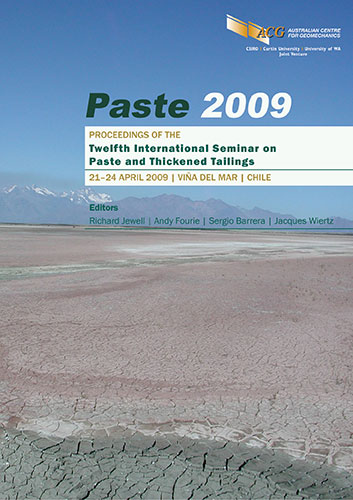Factorial Design 2n in Bauxite Tailings Flocculation and Bingham Model for Rheological Characteristics

|
Authors: de Araujo, AC; Valadão, GES; Falcucci, A |
DOI https://doi.org/10.36487/ACG_repo/963_2
Cite As:
de Araujo, AC, Valadão, GES & Falcucci, A 2009, 'Factorial Design 2n in Bauxite Tailings Flocculation and Bingham Model for Rheological Characteristics', in R Jewell, AB Fourie, S Barrera & J Wiertz (eds), Paste 2009: Proceedings of the Twelfth International Seminar on Paste and Thickened Tailings, Australian Centre for Geomechanics, Perth, pp. 11-20, https://doi.org/10.36487/ACG_repo/963_2
Abstract:
In the last years, the disposal of tailings in the form of pastes and/or high-density slurries has gained importance as it may present significant advantages in comparison to more traditional disposal techniques. The knowledge of physical chemical characteristics of the material to be disposed, as well as the interactions that result from the use of polymeric flocculants on solid/liquid separation can lead to the formation of pastes and/or high-density slurries with adequate conditions for handling and final disposal. With the help of factorial design tool (2²), with pH and flocculant dosage as independent variables, the effects of three different polyacrylamide flocculants was evaluated on the final per cent solids of a bauxite tailings flocculated material, over a pH range from 5 to 7 and different dosages of flocculants. These factors were analysed by fitting the experimental data to a polynomial model, which plots settling rates response in the form of contour maps. Regarding the final percentage of solids of the flocculated material, a cationic polymer presented the best results among the three flocculants tested. With a dosage of 130 g/t and pH 5, the final percentage of solids (by wt.) was 31.2% after one hour. The rheological characteristics for different percentage of solids are determined with the help of the Bingham model, where the viscosity and yield stress of a bauxite tailing are available without a presence of flocculant. According to the utilised model, the yield stress show a signification increase for to the slurry with 25–30 per cent of solid by weight, with a viscosity of between 8.2 and 13.0 cP and a yield stress between 3.0 and 6.8 Pa.
References:
Barnes, H.A., Hutton, J.F. and Walters, K. (1989) An introduction to rheology, 1st ed. New York: Elsevier, Rheology
Series 3, 199 p.
Boger, D.V. and Nguyen, Q.D. (1998) Application rheology to solving tailings disposal problems, International Journal
of Mineral Processing, Vol. 54, pp. 217–233.
Box, G.E.P., Hunter, W.G. and Hunter, J.S. (1978) Statistics for experimenters, Wiley, New York.
Derjaguin, B. and Landau L. (1941) Theory of the stability of strongly charged lyophobic sols and of the adhesion of
strongly charged particles in solutions of electrolytes, Acta Physico chemica URSS 14:633.
Falcucci, A. (2007) A influência de floculantes poliméricos na formação de pastas minerais, M.Sc. Thesis in Mineral
Processing Technology, Mining Engineering Department – UFMG, Brazil.
Farinato, R.S., Ravishakar, S.A. and Chen, H.T. (2003) Rational polymer design for solid-liquid separations in mineral
processing applications, International Journal of Mineral Processing, Vol. 72, pp. 75–86.
Ferreira, E.E., Brandão, P.R.G., Klein, B. and Peres, A.E.C. (2005) Reologia de suspensões minerais: Uma revisão,
REM: Revista da Escola de Minas, Ouro Preto, Vol. 58(1), pp. 83–87.
Fitch, B. (1966) Current theory and thickener design, Ind. Eng. Chem., Vol. 58(10), pp. 18–28.
Fuerstenau, D.W. and Pradip. (2005) Zeta potentials in the flotation of oxide and silicate minerals, Advances in Colloid
and Interface Science, Vol. 114–115, pp. 9–26.
Hogg, R. (2004) Flocculation by polymers: Mechanisms, dynamics and process design. Journal of Ore Dressing, Vol. 6,
Johnson, S.B., Franks, G.V., Scales, P.J., Boger, D.V. and Healy, T.W. (2000) Surface chemistry-rheology relationships
in concentrated mineral suspensions, International Journal of Mineral Processing, Vol. 58, pp. 267–304.
Kwak, M., James, D.F. and Klein, K.A. (2005) Flow behaviour of tailings paste for surface disposal, International
Journal of Mineral Processing, in press.
Litzenberger, C.G. (2003) Rheological study of kaolin clay slurry, M.Sc. Thesis in Chemical Engineering, University of
Saskatchewan, Saskatoon, SK.
Mular, A.L. and Roberts, R.B. (1966) A simplified method to determine isoelectric points of oxides, Transactions of the
Canadian Institute of Mining and Metallurgy, Canada, pp. 438–439.
Pearse, M.J. (2005) An overview of the use of chemical reagents in mineral processing, Minerals Engineering, Vol. 18,
pp. 139–149.
Ralston, J., Jenkins, P. and Huynh, L. (2000) Modification of the rheological properties of concentrated slurries by
control of mineral-solution interfacial chemistry, International Journal of Mineral Processing, Vol. 59,
pp. 305–325.
Sheridan, M.S., Nagaraj, D.R., Fornasiero, D. and Ralston, J. (2002) The use of factorial experimental design to study
collector properties of N-allyl-O-alkyl thiocarbamate collector in the flotation of a cooper ore, Minerals
Engineering, Vol. 15, pp. 333–340.
Verwey, E.J.W. and Overbeek, J.Th.G. (1948) Theory of the stability of lyophobic colloids, Elsevier, Amsterdam.
20 Paste 2009, Viña del Mar, Chile
© Copyright 2024, Australian Centre for Geomechanics (ACG), The University of Western Australia. All rights reserved.
View copyright/legal information
Please direct any queries or error reports to repository-acg@uwa.edu.au
View copyright/legal information
Please direct any queries or error reports to repository-acg@uwa.edu.au